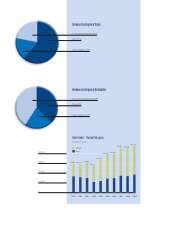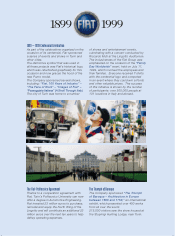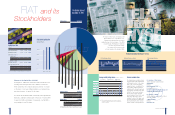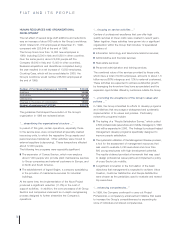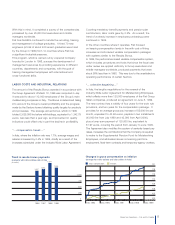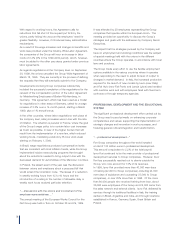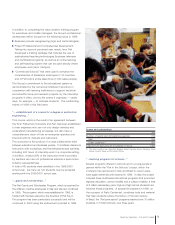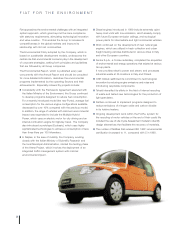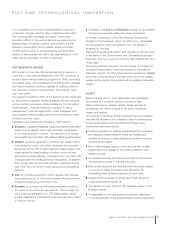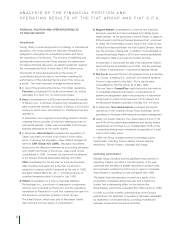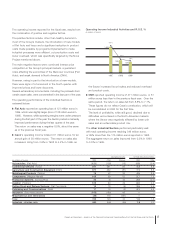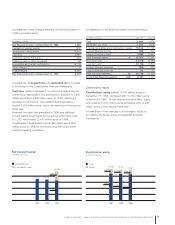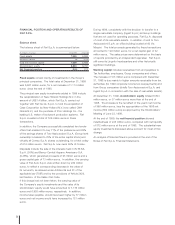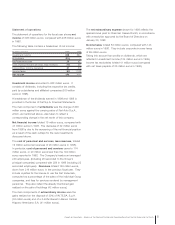Chrysler 1999 Annual Report Download - page 22
Download and view the complete annual report
Please find page 22 of the 1999 Chrysler annual report below. You can navigate through the pages in the report by either clicking on the pages listed below, or by using the keyword search tool below to find specific information within the annual report.
21
Report on Operations – Fiat and Technological Innovation
In a competitive environment characterized by rapid and
continuous change, research plays a significant role within
Fiat’s development strategies and plans. The product
innovation efforts of the various Sectors are supported by
leading-edge, horizontal research conducted by the Fiat
Research Center (FRC) and by Elasis, where more than
14,500 persons work at 131 engineering and innovation
centers in Italy and abroad, with total expenditures of 1,406
million Euros, equivalent to 2.9% of revenues.
FIAT RESEARCH CENTER
With a staff of more than 850 employees and a network of
more than 1,000 external researchers, the FRC continued to
pursue result-oriented research programs in 1999, producing
innovations which, once transferred to the Fiat Sectors, translate
into new competitive solutions capable of creating value for
the customer in terms of performance, time savings, lower
cost, and quality.
The support provided by FRC to the Sectors is also measured
by the number of research results transferred: 88 new products
and production processes, made possible by 146 innovative
methodologies. Special emphasis is placed on “value
management” methodologies which, when integrated with
technological methodologies, permit the optimization of new
products and their costs.
Significant new solutions prototyped in 1999 include:
❚Ecodriver, a system integrating a gasoline internal-combustion
engine and an electric motor with automatic transmission
for a future production vehicle. The objective is to reduce
consumption by more than 30% without affecting performance.
❚Multijet, a second-generation “common rail” system with a
new electronic control unit, which embodies the expertise
developed by the FRC in direct-injection diesel engines and,
when applied to diesel engines, produce continued high
performance while reducing consumption by more than 20%
compared with the existing common rail systems. In addition,
they comply with the European emission standards for the
year 2005 (Euro 4) without costly exhaust post-processing
systems.
❚VVA, an innovative electronic control system that reduces
consumption by up to 15% and increases the performance
of gasoline engines by more than 10%.
❚Ecobasic, a concept car embodying innovative solutions,
the result of more than 50 new patents. This concept car
uses a second-generation 1.2 JTD diesel engine, which
already meets Euro 4 standards and burns less than 3 liters
of fuel per 100 km.
❚In addition, the Save and Chauffeur projects for automated
driving and preventive safety have been completed.
In the first competition of the Fifth Research Framework
Program of the European Union, the FRC won a remarkable
65 new projects, which are added to the 146 already in
progress for the year.
Research projects conducted in Italy included continued work
in the areas of the “Environment” and “Innovative Production
Systems,” and new programs involving “Microelectronics” and
“Fuel Cells.”
During the national convention for the closing of the Second
Focused Transportation Project sponsored by the National
Research Council, the FRC presented the revolutionary Vanzic
prototype, which features a modular aluminum frame, plastic
panels, and an electric drive system with an auxiliary combustion
engine.
ELASIS
Elasis employs about 1,000 researchers and operational
technicians at 7 research centers in Southern Italy.
Elasis continued its research activity aimed primarily at
developing new methodologies in the field of advanced
design and testing.
Its proximity to Southern Italy’s manufacturing hubs facilitate
the effective utilization of its research output to enhance the
products developed and manufactured at these hubs.
Noteworthy examples include:
❚Prototype systems of vehicles characterized by modularity
and flexibility criteria aimed at future car families and
suitable for the use of alternative power systems with low
environmental impact.
❚New methodologies based on the use of virtual models
(Digital Mock Up) applied to the product definition and
design process.
❚Cooperative working techniques and tools for the product
development process in a global company.
❚New architectures for the vehicle’s electrical system based
on the use of CANs (Controller Area Networks) for
transmitting data between electronic control units.
❚Design solutions based on ample use of light alloys for
a high-performance sports car.
❚The design of a new 1000-cc 16V gasoline engine for the
Brazilian market.
❚Development of on-board systems to perform diagnostics
on the functionality of the engine/emission control equipment.
FIAT AND TECHNOLOGICAL INNOVATION



